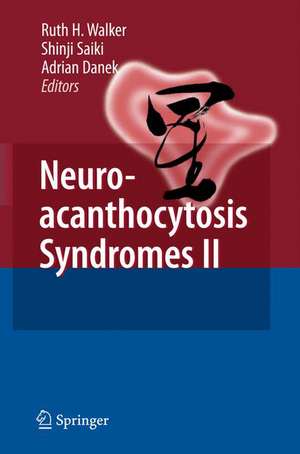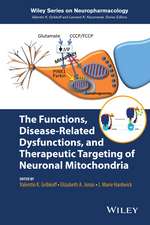Neuroacanthocytosis Syndromes II
Prefață de M. Hallett Editat de Ruth H. Walker Cuvânt înainte de Ginger Irvine, Glenn Irvine Editat de Shinji Saiki, Adrian Daneken Limba Engleză Hardback – 17 dec 2007
| Toate formatele și edițiile | Preț | Express |
|---|---|---|
| Paperback (1) | 945.79 lei 6-8 săpt. | |
| Springer Berlin, Heidelberg – 14 oct 2010 | 945.79 lei 6-8 săpt. | |
| Hardback (1) | 951.91 lei 6-8 săpt. | |
| Springer Berlin, Heidelberg – 17 dec 2007 | 951.91 lei 6-8 săpt. |
Preț: 951.91 lei
Preț vechi: 1160.86 lei
-18% Nou
Puncte Express: 1428
Preț estimativ în valută:
182.15€ • 190.57$ • 151.31£
182.15€ • 190.57$ • 151.31£
Carte tipărită la comandă
Livrare economică 03-17 aprilie
Preluare comenzi: 021 569.72.76
Specificații
ISBN-13: 9783540716921
ISBN-10: 3540716920
Pagini: 324
Ilustrații: XXVI, 295 p.
Dimensiuni: 155 x 235 x 23 mm
Greutate: 0.63 kg
Ediția:2008
Editura: Springer Berlin, Heidelberg
Colecția Springer
Locul publicării:Berlin, Heidelberg, Germany
ISBN-10: 3540716920
Pagini: 324
Ilustrații: XXVI, 295 p.
Dimensiuni: 155 x 235 x 23 mm
Greutate: 0.63 kg
Ediția:2008
Editura: Springer Berlin, Heidelberg
Colecția Springer
Locul publicării:Berlin, Heidelberg, Germany
Public țintă
ResearchCuprins
Forward .- Preface .- Part I: The Neuroacanthocytosis Syndromes.- Neuroacanthocytosis Syndromes – A Current Overview. Differential Diagnosis of Chorea. An Update on Hardie Neuroacanthocytosis Series. Update on McLeod Syndrome. Huntington's Disease-like 2. Neuroacanthocytosis in Japan - Review of The Literature and Cases.- Part II: Basic Research – Proteins and Erythrocytes.- The Function of Chorein. Recent studies of Kell and XK: Expression Profiles of Mouse Kell and XK mRNA. Questions of Cell Shape. Neuroacanthocytosis-related Changes In Erythrocyte Membrane Organization And Function. McLeod syndrome: A perspective from Japanese Blood Centers.- Part III: Animal Models.- A Mouse Model of Chorea-acanthocytosis. Part IV: The Structural Basis of Brain Involvement in Neuroacanthocytosis .- Functional Imaging in Neuroacanthocytosis. Volumetric Neuroimaging in Neuroacanthocytosis. Neuropathology of Chorea-acanthocytosis. The Neuropathology of McLeod Syndrome. Cerebral Involvement in McLeod Syndrome: The First Autopsy Revisited.- Part V: Clinical Aspects and Therapy.- Psychiatric morbidity in NA (title to be updated). Muscular Aspects of Chorea-acanthocytosis. Impaired Autonomic Dysfunction in Neuroacanthocytosis and Causes of Sudden Death: Analysis of a Case of Chorea-acanthocytosis with Dysautonomia. Sleep Disorders in Neuroacanthocytosis. Neurosurgery for Neuroacanthocytosis. Speech/occupational therapy in neuroacanthocytosis.- Part VI: The Way Forward.- Virtual Neuroacanthocytosis Institute – A Look Forward
Textul de pe ultima copertă
Neuroacanthocytosis refers to a group of rare neurodegenerative disorders, the symptoms of which typically resemble Huntington’s disease. One defining feature is the presence of thorny red blood cells (acanthocytes); however, neither the role of the genetic mutations in causing acanthocytosis, nor the connection with the basal ganglia neurodegeneration, is yet understood. At present there is no cure for these disorders and treatment is purely symptomatic.
Awareness of neuroacanthocytosis disorders has increased significantly in recent years. There have been a number of important developments in the field since the publication of the first volume, Neuroacanthocytosis Syndromes. This book contains the latest research in this area.
Recent advances have identified the range of mutations in the causative genes, shedding light on potential phenotypegenotype correlations. Studies of the proteins affected in these disorders have resulted in increased understanding of their functions and distribution. In vitro studies have identified potential protein interactions, which have important implications for pathophysiology. Work on erythrocyte membranes suggests mechanisms for the generation of acanthocytes. Animal models are being generated which will greatly facilitate understanding the role of gene mutations in humans, and provide the foundation for possible therapeutic interventions. In addition, advances in other neurodegenerative disorders, such as Huntington’s and Parkinson’s diseases, have implications for neuroacanthocytosis.
Awareness of neuroacanthocytosis disorders has increased significantly in recent years. There have been a number of important developments in the field since the publication of the first volume, Neuroacanthocytosis Syndromes. This book contains the latest research in this area.
Recent advances have identified the range of mutations in the causative genes, shedding light on potential phenotypegenotype correlations. Studies of the proteins affected in these disorders have resulted in increased understanding of their functions and distribution. In vitro studies have identified potential protein interactions, which have important implications for pathophysiology. Work on erythrocyte membranes suggests mechanisms for the generation of acanthocytes. Animal models are being generated which will greatly facilitate understanding the role of gene mutations in humans, and provide the foundation for possible therapeutic interventions. In addition, advances in other neurodegenerative disorders, such as Huntington’s and Parkinson’s diseases, have implications for neuroacanthocytosis.
Caracteristici
Includes supplementary material: sn.pub/extras











